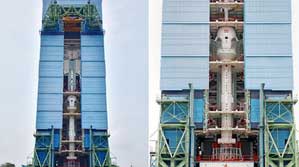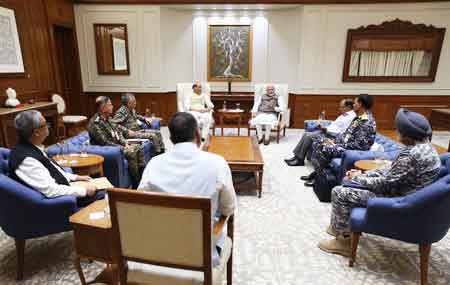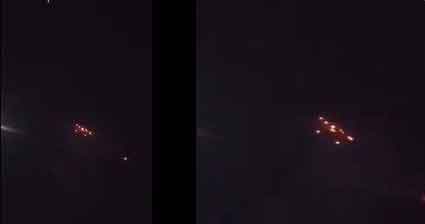The countdown for the first Flight Test Vehicle Abort Mission-1 (TV-D1) on Saturday to demonstrate the crew escape system of the Indian rocket that would carry its astronauts to the space will begin at 8 a.m. on Friday, a senior Indian Space Research Organisation (ISRO) official said.
India plans to orbit its astronauts in space in its own rocket for the first time sometime in 2025 and testing the crew escape system is part of that and the flight of TV-D1 will happen at 8 a.m. on Saturday, the official told IANS.
This will be the first of the four test flights, said ISRO Chairman S.Somanath.
According to ISRO, the Saturday flight is for flight demonstration and evaluation of test vehicle sub systems; flight demonstration and evaluation of Crew Escape System including various separation systems and crew module characteristics and deceleration systems demonstration at higher altitude and its recovery.
Measuring about 35 tall and weighing about 44 tonne, the test vehicle/rocket uses a modified Vikas engine which is powered by liquid fuel.
The crew module and crew escape system are mounted at the fore end of the rocket.
The entire flight sequence -- from the test rocket’s lift off to the crew module touchdown at the sea with the deployment of parachutes -- will take about 531 seconds or about nine minutes.
According to ISRO, the mass of the crew module is 4,520 kg and is a single walled unpressurised aluminium structure.
At about 60 seconds into the flight and at an altitude of 17 km, the test vehicle and the crew escape system will get separated.
And 91 seconds after the lift off, the crew module and crew escape system will get separated.
Subsequently, the abort sequence will be executed autonomously commencing with the separation of crew escape system and deployment of the series of parachutes, finally culminating in the safe touchdown of the crew module in the sea, about 10 km from the coast of Sriharikota, ISRO said.
The crew module will house the astronauts in a pressurised earthlike atmospheric condition during the real human space mission.
Currently the crew module for the Gaganyaan mission is in different stages of development.
The TV-D1 is an unpressurised version but has an overall size and mass of actual Gaganyaan crew module and would house all the systems for the deceleration and recovery.
The avionics systems in the crew module are in a dual redundant mode configuration for navigation, sequencing, telemetry, instrumentation and power.
According to ISRO, the crew module in this mission is extensively instrumented to capture the flight data for evaluation of the performance of various systems.
The deceleration of the crew module will be done with parachutes with pyro systems.
The parachute deployment initiation will be done when the crew module is at about 17 km altitude.
The crew module will splash down on the sea at about 10 km from the launch pad at Sriharikota at about 531 seconds after the rocket’s lift off and would float till it was recovered by the Indian Navy.
Recovery ships will approach the crew module and a team of divers will attach a buoy, hoist it using a ship crane and bring it to the shore.
The crew escape system will hit the sea at about 14 km from Sriharikota. This Test Vehicle mission with this crew module is a significant milestone for the overall Gaganyaan programme as a near-complete system is integrated for a flight test.
The success of this test flight will set the stage for the remaining qualification tests and unmanned missions, leading to the first Gaganyaan mission with Indian Astronauts, ISRO said.






Operation Sindoor: PM Modi meets Rajnath Singh, NSA Doval and three service chiefs
In the backdrop of the ongoing ‘Operation Sindoor’, Prime Minister Narendra Modi chaired a high-level meeting attended by Defence Minister Rajnath Singh, National Security Advisor Ajit Doval, Chief of Defence Staff General Anil Chauhan, and Chiefs of the Armed Forces and senior officials.
11 more Bangladeshi nationals held in Tripura
The Tripura Frontier of the Border Security Force (BSF), jointly with state police, on Friday apprehended 11 more Bangladeshi nationals, including four women and four children, officials said.
Railway Protection Force tightens security in NFR zone
In response to escalating security challenges across the country, Railway Protection Force (RPF) of the Northeast Frontier Railway (NFR) has significantly strengthened its security protocols at stations, trains and railway premises, an official said on Friday.
India opposes IMF lifeline for Pakistan due to terror financing risk
India strongly opposed further financial assistance from the IMF to Pakistan at the executive board meeting held on Friday, expressing serious concerns over Islamabad’s track record and the fact that the bailouts were enabling the cash-strapped country to sponsor cross-border terrorism.
Sirens echo across Jammu as 'blasts' trigger blackout; CM Omar Abdullah posts urgent advisory on social media
Jammu city plunged into darkness late Friday evening after a series of blasts were heard across the region, prompting authorities to sound emergency alarms and urge citizens to stay indoors.
Enough rice, wheat, sugar, oil and pulses stock, no need to panic: Pralhad Joshi
The government on Friday reiterated that there is no shortage of essential commodities in the country, and citizens are advised not to panic or rush to the markets to purchase food grains.
Indian carriers cancel flights to 24 airports till May 15 as tensions flare up
Indian carriers on Friday announced that flights to 24 airports had been cancelled till May 15, following a notification from aviation authorities on the continued closure of multiple airports in the country.
New low even for Pakistan: India hits out at Islamabad for targetting religious places
As Pakistani troops continued resorting to heavy mortar shelling on the Indian side along the Line of Control (LoC), India on Friday slammed the rogue nation for specifically targetting religious places labelling it as a "new low even for Pakistan".